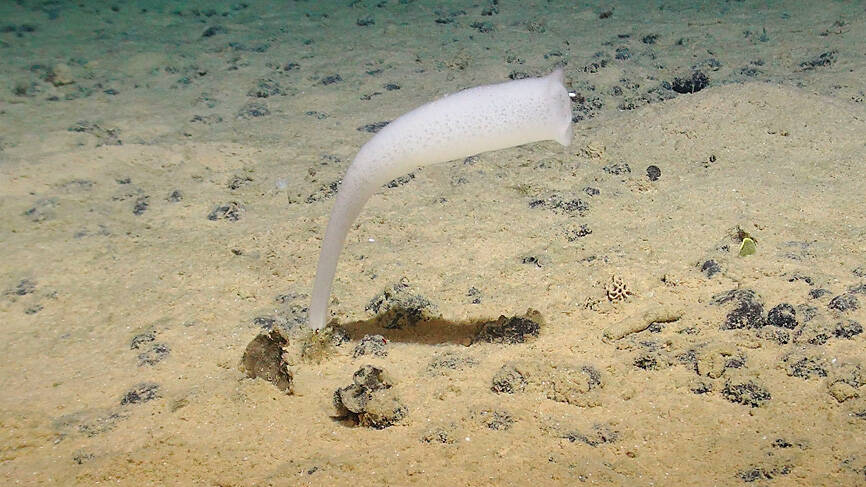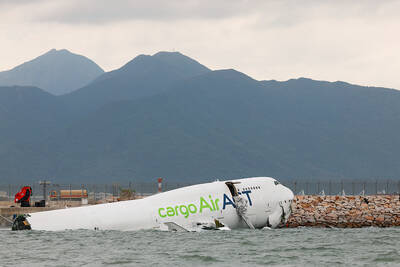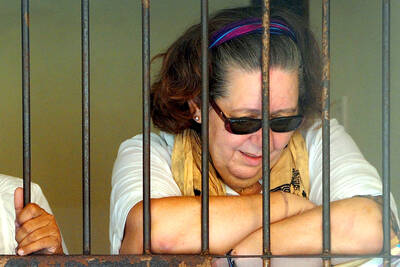Could lumpy metallic rocks in the deepest, darkest reaches of the ocean be making oxygen in the absence of sunlight?
Some scientists think so, but others have challenged the claim that so-called “dark oxygen” is being produced in the lightless abyss of the seabed.
The discovery — detailed in July last year in the journal Nature Geoscience — called into question long-held assumptions about the origins of life on Earth, and sparked intense scientific debate.

Photo: AFP
The findings were also consequential for mining companies eager to extract the precious metals contained within these polymetallic nodules.
Researchers said that potato-sized nodules could be producing enough electrical current to split seawater into hydrogen and oxygen, a process known as electrolysis.
This cast doubt on the long-established view that life was made possible when organisms started producing oxygen via photosynthesis, which requires sunlight, about 2.7 billion years ago.
“Deep-sea discovery calls into question the origins of life,” the Scottish Association for Marine Science said in a press release to accompany the publication of the research.
Environmentalists said the presence of dark oxygen showed just how little is known about life at these extreme depths, and supported their case that deep-sea mining posed unacceptable ecological risks.
“Greenpeace has long campaigned to stop deep sea mining from beginning in the Pacific due to the damage it could do to delicate, deep sea ecosystems,” it said, adding: “This incredible discovery underlines the urgency of that call.
The discovery was made in the Clarion-Clipperton Zone, a vast underwater region of the Pacific Ocean between Mexico and Hawaii of growing interest to mining companies. Scattered on the seafloor 4km beneath the surface, polymetallic nodules contain manganese, nickel and cobalt, metals used in electric vehicle batteries and other low-carbon technologies.
The research that gave rise to the dark oxygen discovery was partly funded by a Canadian deep-sea mining business, The Metals Co, that wanted to assess the ecological impact of such exploration.
It has sharply criticized the study by marine ecologist Andrew Sweetman and his team as plagued by “methodological flaws.”
Metals Co environmental manager Michael Clarke said the findings “are more logically attributable to poor scientific technique and shoddy science than a never-before observed phenomenon.”
Sweetman’s findings proved explosive, with many in the scientific community expressing reservations or rejecting the conclusions.
Since July, five academic research papers refuting Sweetman’s findings have been submitted for review and publication.
“He did not present clear proof for his observations and hypothesis,” said Matthias Haeckel, a biogeochemist at the GEOMAR Helmholtz Centre for Ocean Research in Kiel, Germany. “Many questions remain after the publication. So, now the scientific community needs to conduct similar experiments etc, and either prove or disprove it.”
Olivier Rouxel, a geochemistry researcher at Ifremer, the French national institute for ocean science and technology, said there was “absolutely no consensus on these results.”
“Deep-sea sampling is always a challenge,” he said, adding it was possible that the oxygen detected was “trapped air bubbles” in the measuring instruments.
He was also skeptical about deep-sea nodules, some tens of millions of years old, still producing enough electrical current when “batteries run out quickly.”
“How is it possible to maintain the capacity to generate electrical current in a nodule that is itself extremely slow to form?” he asked.
When contacted by Agence France-Presse, Sweetman indicated that he was preparing a formal response.
“These types of back and forth are very common with scientific articles and it moves the subject matter forward,” he said.

A missing fingertip offers a clue to Mako Nishimura’s criminal past as one of Japan’s few female yakuza, but after clawing her way out of the underworld, she now spends her days helping other retired gangsters reintegrate into society. The multibillion-dollar yakuza organized crime network has long ruled over Japan’s drug rings, illicit gambling dens and sex trade. In the past few years, the empire has started to crumble as members have dwindled and laws targeting mafia are tightened. An intensifying police crackdown has shrunk yakuza forces nationwide, with their numbers dipping below 20,000 last year for the first time since records

CAUSE UNKNOWN: Weather and runway conditions were suitable for flight operations at the time of the accident, and no distress signal was sent, authorities said A cargo aircraft skidded off the runway into the sea at Hong Kong International Airport early yesterday, killing two ground crew in a patrol car, in one of the worst accidents in the airport’s 27-year history. The incident occurred at about 3:50am, when the plane is suspected to have lost control upon landing, veering off the runway and crashing through a fence, the Airport Authority Hong Kong said. The jet hit a security patrol car on the perimeter road outside the runway zone, which then fell into the water, it said in a statement. The four crew members on the plane, which

Japan’s ruling Liberal Democratic Party (LDP) and its junior partner yesterday signed a coalition deal, paving the way for Sanae Takaichi to become the nation’s first female prime minister. The 11th-hour agreement with the Japan Innovation Party (JIP) came just a day before the lower house was due to vote on Takaichi’s appointment as the fifth prime minister in as many years. If she wins, she will take office the same day. “I’m very much looking forward to working with you on efforts to make Japan’s economy stronger, and to reshape Japan as a country that can be responsible for future generations,”

Indonesia was to sign an agreement to repatriate two British nationals, including a grandmother languishing on death row for drug-related crimes, an Indonesian government source said yesterday. “The practical arrangement will be signed today. The transfer will be done immediately after the technical side of the transfer is agreed,” the source said, identifying Lindsay Sandiford and 35-year-old Shahab Shahabadi as the people being transferred. Sandiford, a grandmother, was sentenced to death on the island of Bali in 2013 after she was convicted of trafficking drugs. Customs officers found cocaine worth an estimated US$2.14 million hidden in a false bottom in Sandiford’s suitcase when